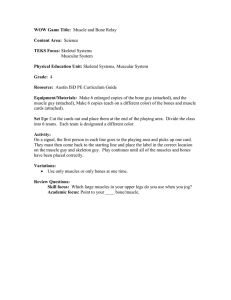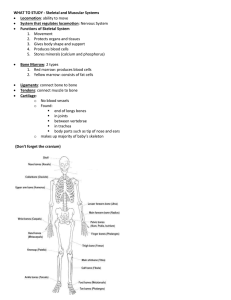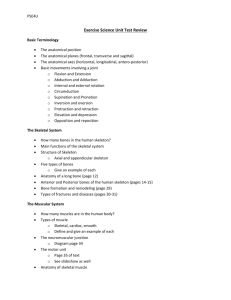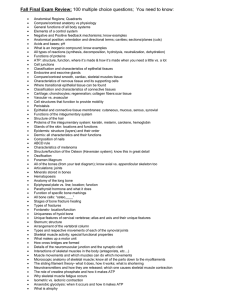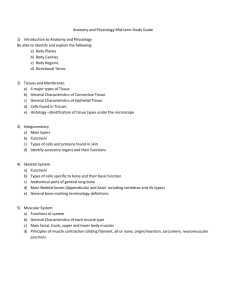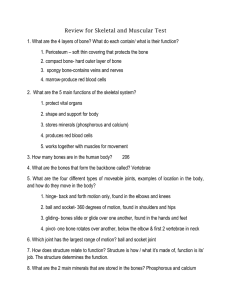Exam Review
advertisement
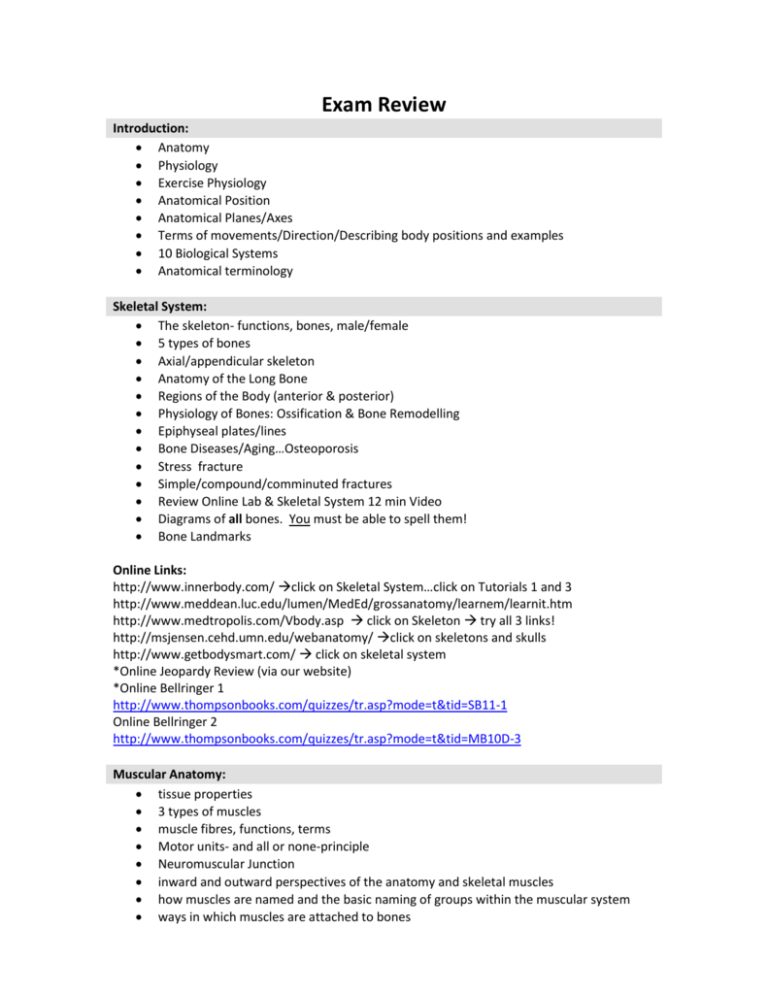
Exam Review Introduction: Anatomy Physiology Exercise Physiology Anatomical Position Anatomical Planes/Axes Terms of movements/Direction/Describing body positions and examples 10 Biological Systems Anatomical terminology Skeletal System: The skeleton- functions, bones, male/female 5 types of bones Axial/appendicular skeleton Anatomy of the Long Bone Regions of the Body (anterior & posterior) Physiology of Bones: Ossification & Bone Remodelling Epiphyseal plates/lines Bone Diseases/Aging…Osteoporosis Stress fracture Simple/compound/comminuted fractures Review Online Lab & Skeletal System 12 min Video Diagrams of all bones. You must be able to spell them! Bone Landmarks Online Links: http://www.innerbody.com/ click on Skeletal System…click on Tutorials 1 and 3 http://www.meddean.luc.edu/lumen/MedEd/grossanatomy/learnem/learnit.htm http://www.medtropolis.com/Vbody.asp click on Skeleton try all 3 links! http://msjensen.cehd.umn.edu/webanatomy/ click on skeletons and skulls http://www.getbodysmart.com/ click on skeletal system *Online Jeopardy Review (via our website) *Online Bellringer 1 http://www.thompsonbooks.com/quizzes/tr.asp?mode=t&tid=SB11-1 Online Bellringer 2 http://www.thompsonbooks.com/quizzes/tr.asp?mode=t&tid=MB10D-3 Muscular Anatomy: tissue properties 3 types of muscles muscle fibres, functions, terms Motor units- and all or none-principle Neuromuscular Junction inward and outward perspectives of the anatomy and skeletal muscles how muscles are named and the basic naming of groups within the muscular system ways in which muscles are attached to bones agonist & antagonist identify and name muscles- *diagrams of hands and foot not included on exam Muscle flash cards- ORIGIN & INSERTION will NOT be on the exam!!! Muscle presentations-*recognize the names and regions in the body they belong to: i.e. semitendinosus is part of the hamstrings group muscular contractions- 3 types muscle contraction during exercise-3 types Sliding filament theory…roles of ATP, CA2+ … myosin crossbridges…etc. how muscle fibres respond to physical training Hypertrophy, hyperplasia, atrophy… Effects of resistance training, benefits, self-esteem and performance Joint Mechanics: structural and functional classifications and characteristics, types of synovial joints and characteristics, examples of joints the knee joint, ACL injuries Sports Injuries…tendonitis, stress fractures, ankle sprains, shoulder injuries, dislocation vs. separation, torn cartilage…etc. PFS, Osgood-Schlatter Syndrome, Pott’s Fracture…etc. Categories-1st Degree-2nd Degree-3rd Degree Signs-SHARP Treatment-PIER Energy Systems: 1. What is ATP? How is it formed (reactions)? What is it used for? 2. What are the two energy systems? 3. What are the three metabolic pathways? 4. Explain are the main characteristics of the three metabolic pathways. 5. What set of reactions are part of each of the three metabolic pathways? 6. Describe the effects of Lactic Acid. 7. What is oxygen debt? 8. How is lactate converted back to glucose? What is gluconeogenesis? 9. What is anaerobic threshold? How does one increase anaerobic threshold? 10. What is VO2 Max? 11. How do the systems work together? How does one train all the systems together? 12. What activities would fall under each system? (show clear examples) 13. Describe the characteristics of each muscle fibre. What types of exercises are each utilized? 14. Know where each of the three types of nutrients are utilized in the body. 15. Explain the importance of myoglobin. Exam Breakdown 135 marks total 90 marks Multiple Choice & True/False 45 marks Written Answers (Charts/Diagrams, Short & Long Answer). ***This exam is worth 15% of your final grade.
